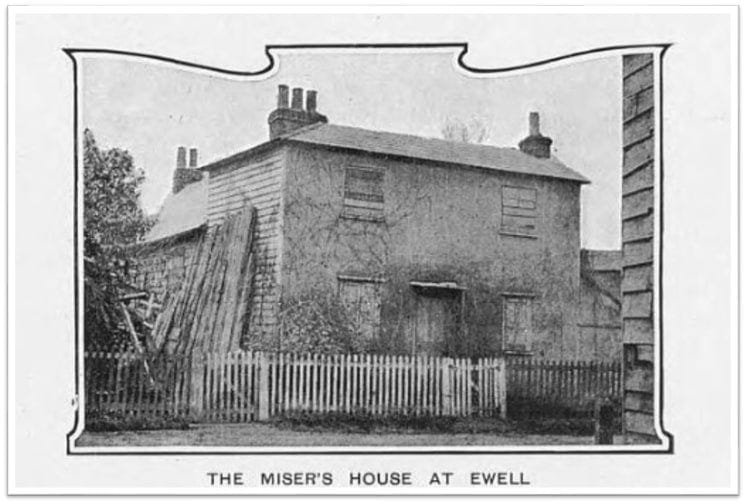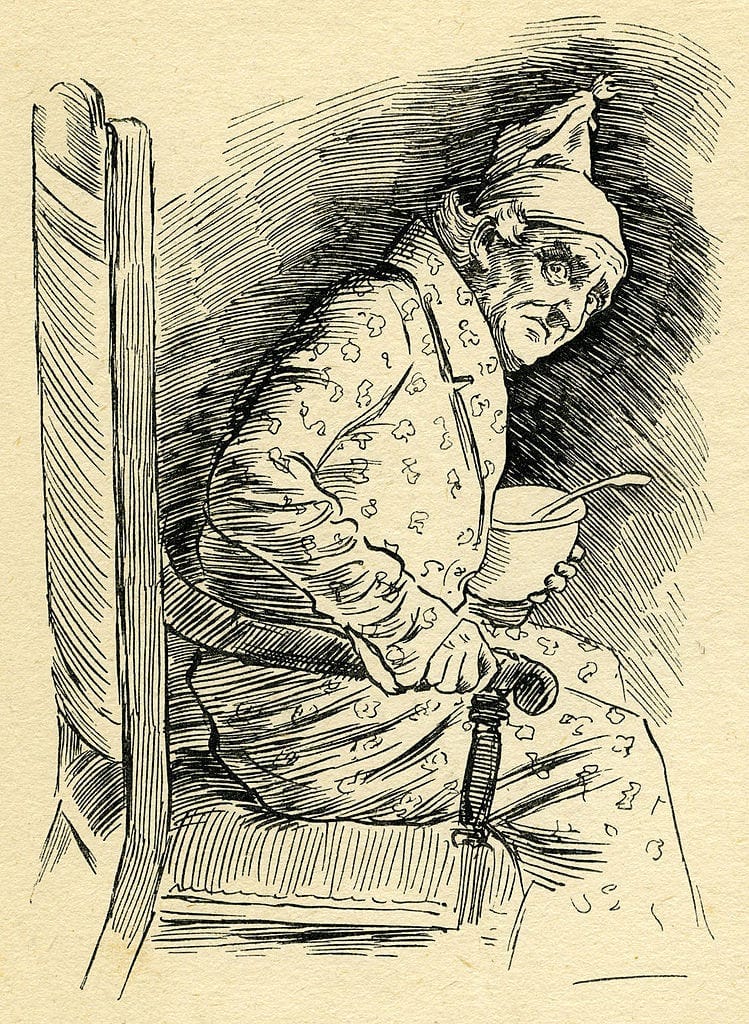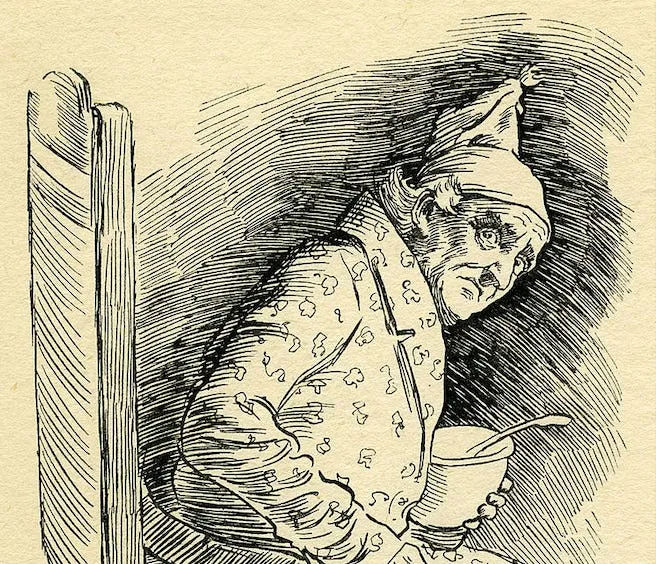By Dr Thomas McGrath
The state of her neighbour’s health had played on the mind of Mary Warren all night. She could not shake the image of 74-year-old Clara Alice Jones shuffling around her back yard looking pale and unwell. In the morning Mary went next door to check on the elderly lady, but no one answered her persistent knocking. Alarmed, she went to find a public telephone to call Mr Wolstenholme, Clara’s solicitor and her only known familial connection.
When Wolstenholme arrived at the house, he found the door locked. Then, somewhat gingerly, he pressed his face against the rotting sashes to see inside. At first his vision was obscured by the grimy panes and bits of packing crates that had been nailed over the broken glass. However, as his eyes adjusted to the gloom, he saw a few sparse furnishings — some chairs, a Welsh dresser coated in a thick layer of dust — and, laying on the sofa, bare-footed and covered in rags, the body of Clara Jones. A doctor was called, and the door was forced open, but it was too late. She had already passed away from pneumonia.
Clara died in 1926, and while the twenties may have been roaring in other areas of Manchester, they certainly weren’t in the part of Castlefield where Clara lived. It was not uncommon to find all manner of people — elderly, young, single, or families — living in abject poverty in narrow streets and dreary back-to-backs. Clara actually lived in a slightly larger three-up, three-down terraced house, but even Rice Street had been officially classified as a slum for decades by that point.

Clara, though, was different from her neighbours and the scores of Manchester’s poor. Among the dust, the damp and the fallen plaster was, literally, hidden treasure. Bags of money were littered everywhere; some were well hidden, suggesting that at one time careful thought had gone into secreting the hoards. Others were tossed around casually and carelessly, such as the four £500 banknotes that had been stuffed at the bottom of a shopping basket as though they were yesterday’s newspaper. In all, £2,700 in cash was found hidden among the nooks and crannies of the house, which amounts to over £166,000 when adjusted to modern currency values. Moreover, bank books, shares and securities were found, resulting in Clara’s estate being valued at £44,657. This means that the little old lady who had lived for decades in the back streets of Manchester, who was described as looking like ‘a beggar’, was the modern equivalent of a multi-millionaire.
Once the story broke, first in local papers and then in the national press, people wondered how Clara ended up in her situation. Great interest was aroused by the fact she had died without leaving a will, and with no known next of kin, many Joneses from all over the country, and even as far away as America, suddenly claimed a long-lost cousin.
Miserly behaviour, as Clara personified, was not unusual in the nineteenth and early-twentieth centuries. You only need to look at two of the most popular novels by Charles Dickens, A Christmas Carol and Great Expectations, to see how these figures seeped into popular fiction. We can see elements of Ebenezer Scrooge and Miss Havisham in Clara Jones, such as the fact she begrudged spending any money, living on just 10 shillings a week despite having an income of £2,000 a year, and shutting herself away, while everything slowly decayed and disintegrated around her. Her neighbours knew she collected the rents for their houses, but they also knew that they had seen bailiffs at her door. They may have thought Clara owed money to a moneylender or pawnbroker, but she actually owed the taxman — she loathed paying income tax on her wealth. Almost everyone who came across the case was baffled as to why anyone would choose to live in such impoverished conditions when they could easily afford a comfortable or even an extravagant lifestyle.

Clara was not Manchester’s only miser. The year before Clara died, 73-year-old Jane Magill was found dead in her home on Lees Road, Oldham. Like Clara, Jane had lived in such impoverished conditions that her body was described as ‘emaciated’, and her home was ‘verminous’. After her death, £1,800 (over £109,000 today) was found hidden around the home, nestled in between three cart loads worth of papers in the living room, inside plant pots, fans, baskets and even among the ashes in the grate. Many years earlier, in 1875, the body of 74-year-old James Swift was found in his property on Horne Street, Ancoats. Like Jane and Clara, he lived very frugally, with only a few bits of furniture, and he deliberately kept himself secluded from neighbours. Despite his death occurring in November, he had not lit a fire for some time, yet authorities still found £2,000 worth of gold (over £200,000 today) and £6,000 in bank notes, deeds and mortgages (over £600,000 today).
Each case has striking similarities that cut across the different time periods and locations, and more generally link up with other discoveries of ‘miser’s hoards’ nationally in this period. Each person hoarded money and lived well within their means, to the extent they denied themselves basic comforts such as heating or freshly cooked meals. Each had property, stocks and shares as well as cash. All were single, reclusive and shut off from forming relationships. Both Clara and Jane relied on a singular chosen female neighbour for assistance when necessary, but they did not form active friendships and the front door acted as a boundary which could not be crossed. At Clara’s funeral it was noted that there was only one wreath on the coffin, and only her solicitor, her few tenants and a policeman attended the service.
What would prompt these wealthy individuals to live in circumstances which were at the extremities of domesticity? Without speculating on the mental health of these individuals, it seems there are connecting themes with these cases and our current understanding of the condition of hoarding. Even in the nineteenth century, links were being made between miser’s hoards and medical conditions — these were not seen as quirky habits. Hoarding in this period is only really visible in sources concerning extreme cases such as Clara’s, when money was collected, given the popular aesthetic for cluttered and crowded interiors which cut across the class system at the time.

Clara, Jane and James may have hidden huge sums of money around their houses as a ‘rainy day fund’. It’s likely that all three distrusted the banks, which could (and did) fail in the nineteenth century. It’s not known if they experienced loss in their lives, either financial or personal, in which they might therefore derive a sense of comfort from having the money or possessions around them at home. There may have been an element of control over their own decisions and their futures too, which comes with having money readily available. We also can’t discredit their age. These domestic habits were clearly formed over a number of years, but the general disorder and chaos inside the home could be due to ill health, infirmity or forgetfulness. The house, like the money and valuable documents within it, is another possession. It is conversely a safe space, yet also one which represents an omnipresent danger from thefts, tripping, or illness from the dilapidated conditions, as well as possibly acting as a tangible icon of shame or embarrassment.
Clara had a strong emotional tie to the house, which dictated how she used her domestic space. She had lived with her parents and her unmarried older sister at Rice Street since she was around 17 years old. Her habits may have been learned from her parents, as her father was a painter-turned-property developer who aimed to make £10,000 before he died. His drawings were found in the house, and they were all of strict evangelical themes — drunkenness, theft, obscenity and religion — suggesting Clara may have had quite a strict and moral upbringing. Written underneath one sketch was ‘the first and last time a fire was lit in this parlour’ and under another ‘talk to me with £4000 Ha! Ha!’ His financial gains were at least partially achieved through scrimping and saving and denying his family the chance to live and move in more affluent social circles, something which clearly made a lifelong impression on his daughters.
After the deaths of the parents, Clara and her sister then lived solely in the cellar, but Clara moved up to the ground floor when her sister died in 1919. For the next seven years Clara never used the cellar rooms again, and passers-by could peek at furniture covered in layers and layers of thick dust. Clara’s home was therefore a multi-layered hideaway, firstly from the outside world and then further hidden elements inside. As the Manchester Guardian noted ‘[her] mind was doomed to run in these lightless burrows.’
After the press sensation died down, Clara’s name, like her life, slipped away silently. There is an age-old saying that “you can’t take it with you”, and in the end, after two years and many legal proceedings, Clara Alice Jones’s wealth, a lifetime of denying herself the basic comforts of human existence, was distributed among four lucky distant cousins and their children. The stories of misers became more and more infrequent as slum clearance projects swept away the worst of the tangible legacies of poverty. Health, housing and social care was improved, and banks became stabilised. We often think we know our neighbours, certainly those we share walls with. Yet these few glimpses into the lives of ‘real life Scrooges’ give us a much more colourful, and somewhat heartbreaking insight into what went on behind closed doors.

Comments
How to comment:
If you are already a member,
click here to sign in
and leave a comment.
If you aren't a member,
sign up here
to be able to leave a comment.
To add your photo, click here to create a profile on Gravatar.






